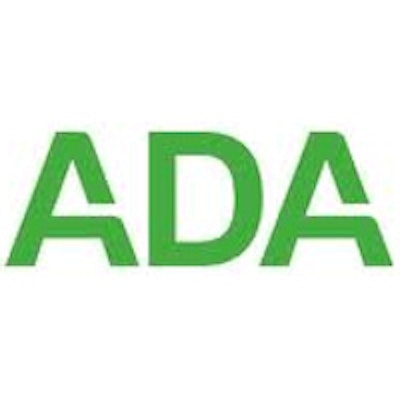
This year more than 181 million Americans won't visit a dentist, nearly half of people older than 30 suffer from some form of periodontal disease, and about 1 in 4 children younger than age 5 already has caries, according to the ADA. More than 2.1 million people showed up in U.S. emergency rooms (ERs) with dental pain in 2010, double the number from a decade ago.
While the national healthcare debate has focused on the Patient Protection and Affordable Care Act, other issues such as access to dental care were pushed aside. In response, the ADA created Action for Dental Health (ADH), a nationwide, community-based movement and grassroots effort to address barriers to dental health by solving today's problems through direct help and creating sustainable solutions that provide the best quality of care. The ADH has taken root in every state, according to the ADA.
“Millions of Americans continue to face barriers to dental care, which is why the ADA launched Action for Dental Health.”
To document the efforts being made through the program, the ADA released the first "Action for Dental Health: Report to Congress" during the ADA's annual Washington Leadership Conference, held this week in Washington, DC.
"Millions of Americans continue to face barriers to dental care, which is why the ADA launched Action for Dental Health," said ADA President Charles H. Norman III, DDS. "While we have accomplished much in the first year, there is still much to do. This 'Report to Congress' serves as a continued call to action for elected officials, health policy organizations, community leaders, and the dental community to come together to bridge the dental divide."
The ADA has set goals for Action for Dental Health, including the following:
- Creating ER interception programs to reduce the burden on our nation's emergency rooms and improving dental health in 25 states by 2015, as well as 50 states and the District of Columbia by 2020.
- Training at least 1,000 dentists to provide care in nursing homes, one of the most underserved populations, by 2020 and increasing the number of dentists serving on advisory boards or as dental directors of long-term care facilities.
- Expanding programs that provide screening and treatment to help people in need connect with dentists for continuity of care and work to eliminate cavities in children younger than age 5 in the U.S. by 2020.
- Improving the existing safety net and helping people connect with community resources and dentists who can provide care by increasing the number of states with active community dental heath coordinators (CDHCs) to 15 states by 2015. CDHCs provide dental health education and help people in underserved areas connect to community health resources and dentists for needed treatment. Currently, eight states have CDHCs.
- Reducing the proportion of both adults and children younger than age 18 with untreated dental decay by 15% by 2020, exceeding the 10% Healthy People 2020 goal by 50%.
- Increasing the proportion of low-income children who received any preventive dental services during the past year by 15% by 2020, exceeding the 10 % Healthy People 2020 goal by 50%.
The report also outlines four strategies and corresponding programs that are contributing to the success of the movement:
- Providing care now. This includes hospital emergency room referral programs to connect people with severe dental pain to dentists who can provide needed treatment and expanding programs such as Give Kids A Smile, which currently provides dental services to approximately 400,000 underserved children at more than 1,500 events.
- Strengthening and expanding the public/private safety net by fighting for increased dental health protections under Medicaid and helping more dentists work with community health centers and clinics.
- Bringing disease prevention and education into communities through CDHCs.
- Working to pass legislation at the federal and state levels that support Action for Dental Health initiatives. The Action for Dental Health Act (HR 4395) would provide grants to support programs such as expanding care for the elderly in nursing homes, encouraging dentists to contract with federally qualified health centers, increasing health protections and simplifying administration under Medicaid, expanding community water fluoridation, increasing the number of CDHCs, and strengthening collaborations with other health professionals and organizations.
To review detailed goals for Action for Dental Health, or to download the "Action for Dental Health: Report to Congress," visit the ADA website.



















